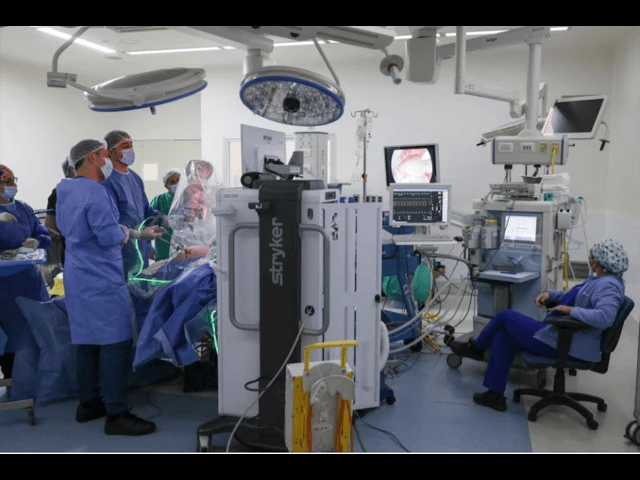In recent developments, the field of surgery is undergoing a significant transformation with the integration of artificial intelligence (AI). The recent laparoscopic surgery conducted by Ricardo Funke, the chief of surgery at Clinica Las Condes in Santiago, Chile, is a noteworthy example. Funke performed a gallbladder removal procedure utilizing an autonomous AI-guided camera, unlocking new potential for surgical practices worldwide. This innovative technology enabled the camera to track the surgeon’s instruments and adjust in real time, marking a pivotal moment in automated medical procedures.
Surgical automation is not merely a buzzword; it represents a tangible shift toward efficiency and precision in the operating room. As the global surgical robot market is projected to escalate from $15.6 billion in 2024 to an astounding $64.4 billion by 2034, the implications for small and medium-sized businesses (SMBs) in the healthcare sector are invaluable. Embracing this technology can lead to improved patient outcomes, reduced risks of surgical errors, and optimized resource allocation.
To implement automation successfully, SMB leaders should consider a series of strategic steps, beginning with identifying specific processes that automation could enhance. For example, workflow bottlenecks can often be targeted for automation. By analyzing surgical schedules, staff allocations, and instrument management, organizations can pinpoint areas where AI and robotic tools may yield significant improvements.
After identifying the appropriate processes, the next logical step is to evaluate available tools. Platforms like Make or Zapier offer robust capabilities to design and implement seamless automation workflows. Businesses should consider employing these tools for various administrative tasks, such as scheduling surgeries, managing inventory, or even tracking patient data. By connecting disparate systems, these tools enable organizations to streamline operations while reducing the burden on staff.
Once the tools are selected, organizations must focus on integration. Engaging with IT professionals familiar with the chosen platforms will facilitate smoother transitions. For instance, integrating AI-powered scheduling software with an existing patient management system can enhance operational efficiency by ensuring that treatment schedules are optimized based on patient needs and resource availability.
Moreover, training staff is crucial for successful automation. Even the best tools will be ineffective without a knowledgeable team capable of leveraging their full potential. Investing in training sessions to familiarize employees with new technologies is not just advisable; it is essential. Providing practical examples of how automation can simplify daily tasks will garner buy-in from staff and promote a culture of innovation within the organization.
Monitoring performance post-implementation should be a regular practice. By assessing the efficacy of automated processes and gathering feedback from both staff and patients, organizations can fine-tune their systems for greater efficiency. Utilizing analytics dashboards can provide valuable insights into which areas the AI and automation are yielding the best results and where further adjustments may be necessary.
Of course, there are risks. The integration of advanced technologies may encounter resistance from staff who are accustomed to traditional methods. Clinicians, in particular, may worry about how automation might affect their roles. Therefore, leaders must approach the transition thoughtfully, openly communicating the benefits while addressing concerns. Building a coalition of advocates within the organization can also help to prompt a more favorable reception to AI.
The return on investment (ROI) from implementing automation in healthcare can be substantial. By reducing the time taken for administrative tasks, lowering error rates in surgeries, and improving patient satisfaction, the financial and operational benefits should outweigh the initial costs involved in the setup. Over time, the efficiencies gained can lead to significant cost savings and potential revenue growth.
Further reinforcing the importance of automation, research from Johns Hopkins University highlights the potential of AI to conduct surgical procedures autonomously. As AI-guided technology continues to evolve, medical professionals are likely to experience a growing reliance on these innovations. Alberto Rodriguez, CEO of Levita Magnetics, emphasized this, stating that we are witnessing the “first step” into a new era of surgical automation.
In summary, integrating AI and automation within healthcare processes is not merely an option but a necessity for SMB leaders seeking competitive advantages. By thoughtfully identifying automation opportunities, choosing the right tools, ensuring effective integration, and training your team, organizations can streamline workflows and enhance operational performance. As the healthcare landscape continues to evolve, those who embrace these technologies may find themselves at the forefront of innovation, setting new standards for patient care.
FlowMind AI Insight: The integration of AI and automation offers SMBs a pathway to optimize operations and improve patient outcomes. As these technologies continue to advance, proactive engagement with automation will be key to staying competitive and effective in the healthcare sector.
Original article: Read here
2025-09-11 02:10:00

